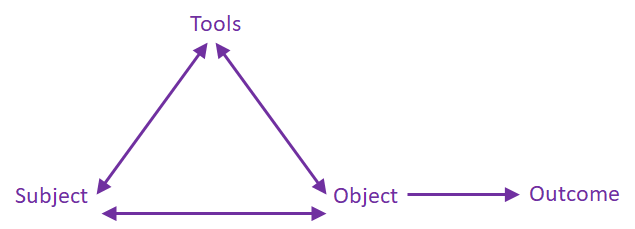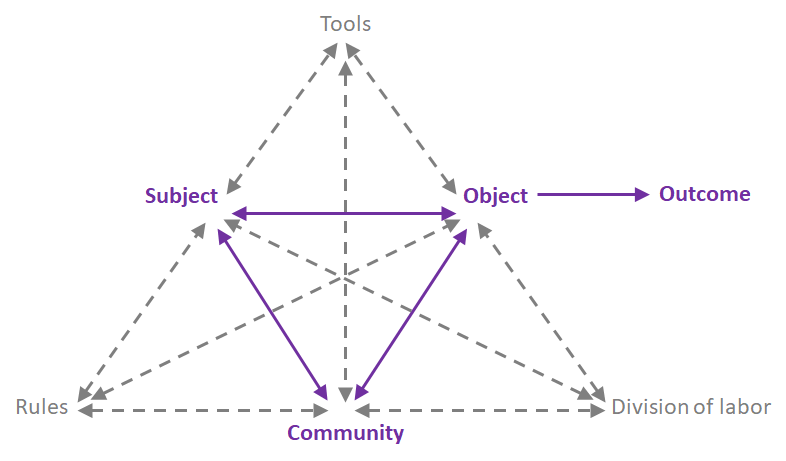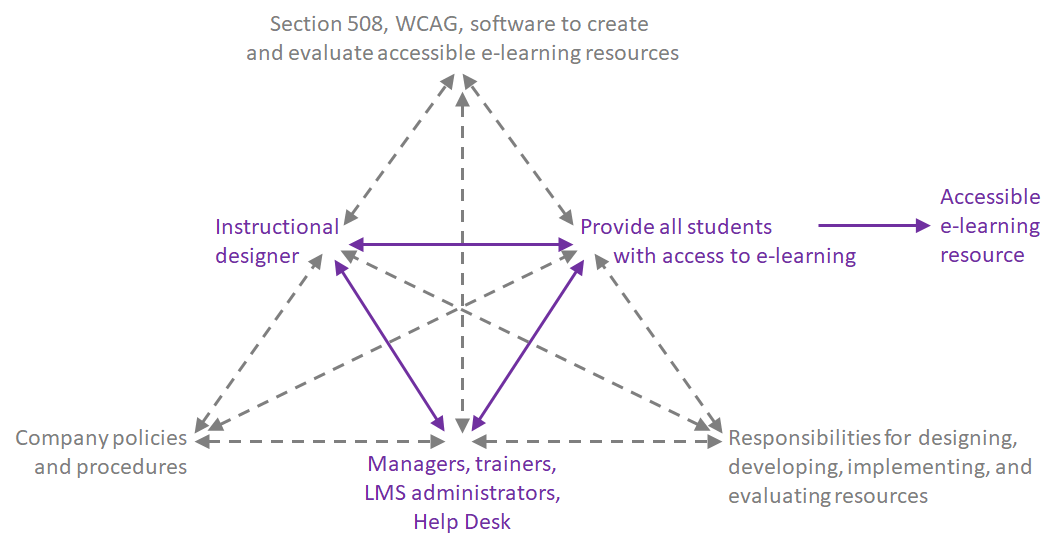Individual responses to accessibility
These notes are part of a series for the book.
Outline
- Introduction
- Activity theory as a potential tool for analysis
- The structure of activity
- The level of an activity
- Key concepts within Activity Theory
- Transformation
- Motivation and consciousness
- Mediation
- History and development
- Contradictions and conflicts
- Applicability of activity theory to e-learning and accessibility
- Identifying the components of an accessible e-learning activity system
- Novice and expert behavior
- Mediation
- Tools
- Rules
- Division of labor
- History and development
- Identifying contradictions in the accessible e-learning system
- Contradictions between the object and the tools
- Contradictions between the object and division of labor
- Contradiction between the community and division of labor
- Contradiction between the community and the rules
- Contradiction between the rules and the subject
- Contradiction between the tools and the subject
- Conclusion
Notes
Activity Theory
Activity Theory focuses on the activity as the smallest unit of analysis. There have been three generations of activity theory, each building on the previous generation.
First generation
Activity Theory came out of Vygotsky’s work. Its goal was to understand the relationship between a person and the reason for an activity they are they are performing. The first generation identified three parts of an activity system:
- Subject: The person undertaking the activity
- Object: The activity’s purpose or objective
- Tools: Physical or conceptual tools used to meet the object (the activity’s purpose)
A few other details are important:
- An activity is long-term, and it is completed in stages. With each stage, an activity’s objective (object) is transformed into outcomes. You can map the components for a long-term activity (such as, building a house) and also for each stage (such as, pouring a foundation or building a frame).
- The idea of transformation is important. Activity Theory doesn’t just look at any action, but specifically focuses on actions that a person purposefully takes because they are motivated to transform something — changing an object (objective) to an outcome. To use the example of a house again, the objective is building a house, and the outcome is a house.
- As a person (subject) becomes more experienced, they gain the knowledge they need to perform their actions more automatically.

Second generation
Researchers later felt that Activity Theory needed to identify more about the context of the activity system. The second generation expanding the original to include three more parts:
- Rules: Rules and conventions of a community, including formal, informal, and technical ones
- Community: People or groups who share the same object (activity’s purpose). The people in a community divide labor and share norms (rules).
- Division of labor: How a group is organized to meet the activity’s objective.
Now that it had six parts, they also began concentrating on three of the relationships in particular:
- Between the person (subject) and the purpose of the activity (object); this relationship is mediated by tools. (That is, the person and activity are connected via tools; tools are the connecting link between the person and the activity.)
- Between the person (subject) and the community; this relationship is mediated by rules.
- Between the purpose of the activity (object) and the community; this relationship is mediated by division of labor.
A few other details are important:
- The mediators (tools, rules, and division of labor) may enable and/or limit the relationships they mediate.
- The idea of contradiction is important. This is a ‘misfit within elements, between them, between different activities or between different developmental phases of a single activity’ (Seale, 2014, p. 256). As people work through a contradiction, they develop (resolve) them. The development means there is a change in the activity system itself. For example, a person (subject) may have a contradiction when they are participating in activities with different objects (objectives). Or, a community may have a contradiction when they begin using a new tool but don’t have rules for using that tool yet.
- Drawing the diagram is useful because it helps you identify contradictions between the components. There are 12 relationships in the diagram (represented by the lines between components), and contradictions can exist along any (or all!) of them. Seale gives examples of conflicts between six of the relationships.

Applying Activity Theory to e-learning
Seale maps the creation of accessible e-learning to the Activity Theory components:

| This component... | In this example, is... | Other examples of the mediating components are... | Contradictions in the relationship between components... |
|---|---|---|---|
| Activity Long-term, purposeful actions to meet a goal | Creating accessible e-learning resources | ||
| Subject Person involved in the activity | The instructional designer who is creating the resource | ||
| Object Activity's objective | Providing all students with access to e-learning | ||
| Community Stakeholders | Senior managers, trainers, LMS administrators, Help Desk | ||
| Outcome Result of transforming the object (objective) | An accessible e-learning resource | ||
| Tools What the person (subject) uses during their actions to meet the goal (activity) | Laws and guidelines such as Section 508 and WCAG; software used to create accessible resource; apps used to evaluate accessibility | Between the person (subject) and the purpose of the activity (object), the relationship is mediated (connected) by tools.
| Between the tool and the objective (object): When the tool is not good enough to create accessible e-learning resources.
Between the tool and the person (subject): When the person cannot use the tools in the way they are supposed to be used, perhaps because they do not understand how they should be used. |
| Rules Formal and informal rules that govern performance at the institution | Company policies and procedures | Between the person (subject) and the community, the relationship is mediated by rules.
Some people debate the effectiveness of specific rules, such as:
| Between the rules and the person (subject): Policies are weak, weakly enforced, inconsistent, confusing, or do not exist, to the point that their lack prevents the person from meeting the objective (object). Between the rules and the stakeholders (community): Stakeholders do not agree on the policies or how they will be implemented. |
| Division of labor Way the community has decided to assign roles and responsibilities | Responsibility for designing, developing, implementing, and evaluating accessible e-learning resources among the instructional designers, senior managers, trainers, LMS administrators, and Help Desk | Between the purpose of the activity (object) and the community, the relationship is mediated by division of labor. Responsibilities are being shared in different ways.
| Between the division of labor and the stakeholders (community): Rules developed by the stakeholders are at odds with (or prevent) the division of labor, or processes developed for the roles and responsibilities do not include all the stakeholders. Between the division of labor and the objective (object): Fragmented division of responsibilities or lack of strategic partnerships which leave stakeholders unable to work together to meet the goal. |
A few details are important:
- In Activity Theory, people (subjects) who are novices gain knowledge over time and are better able to perform their actions without having to think everything through. Seale notes this may not be true for checking the accessibility of e-learning resources. Several studies have found that it is better to hire an expert in this field, and even then it is difficult for experts to remain expert — and they are too expensive for some organizations to afford. This may be helped some by the division of labor.
- The activity of creating accessible learning resource has a history that is worth analyzing so that one can understand the conflicts (and perceived conflicts) and the decisions that were made as a result. For example, there have been conflicts ‘between usability and accessibility, universal design and accessible design, assistive technology and learning technology’ (Seale, 2014, p. 262).